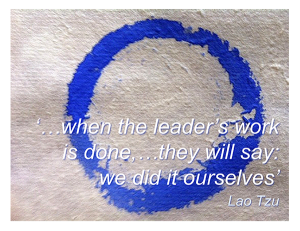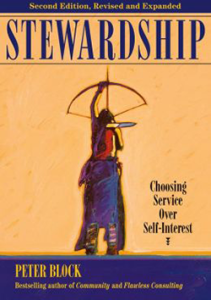The five principles that guide an enabling leader
Leadership with PURPOSE, LOVE, HUMILITY, SERVICE and GRATITUDE
Most leadership models subscribe to a definition of leadership that expects leaders to influence their followers to pursue a common interest or achieve a common goal. This typically positions leaders as being in-charge and/or in-control and reinforces the traditional leader-follower construct. The leader-follower construct is fundamental to the increasingly unpopular command and control leadership and also to the transformational leadership models popular with the so-called visionary leaders of the 1980s.
Leader-follower thinking is also present in the more recent adaptive leadership models. Collective, emergent, and complexity leadership are examples of adaptive models, which are designed to help contemporary organisational leaders deal with the complexity and uncertainty of our time. But the adaptive intent of these models – the need to always remain open, flexible and responsive – is challenged by the need to also have a controlling or directing (leader-follower) dimension. Adaptive leadership models must resolve the tension that exists between the responsibility to manage or direct an outcome, and the opportunity to adapt and allow different, perhaps unexpected, outcomes to emerge.
‘I have Peter Block to thank for a view of leadership that has enriched and sustained my professional career over many years . . . in his 1993 book Stewardship, Choosing Service over Self Interest . . . [he] introduced me to the concept of servant leadership, which challenged the traditional notions of authoritative, controlling and directing leadership. It defined leadership in a way that was inclusive . . . a collective, democratic notion, a privilege, and an obligation that should be embraced by everyone in the organisation (or community) . . . Servant leadership is focused on building community by discovering a shared purpose, developing relationships that work, sharing information, encouraging participation and fostering high levels of interdependence. It is about enabling success through others.’ (The Congruence Framework)
When Robert Greenleaf, the father of servant leadership, said ‘the servant leader is servant first . . . It begins with the natural feeling that one wants to serve, to serve first . . . [and then] to aspire to lead’ he broke the leader-follower mould. The essential difference between servant leadership and other leadership models is its focus on selfless service to others – a focus that redefines leadership as a shared responsibility and a common obligation of the whole organisational community. The tension that confronts leader-follower models is easily resolved through servant leadership. If we frame leadership as a shared responsibility for selfless service, then leadership becomes more about enabling shared outcomes to emerge and less about the implementation of particular outcomes, which has always been, or should have been, the role of management.
Leadership is not about achieving a particular outcome, but about enabling shared outcomes to emerge. Leadership is about creating an environment, a community and a culture within which shared outcomes can be co-created; it is not about managing the realisation of those outcomes. Leadership is not management, but it creates the opportunity for effective management.
Effective leadership, especially in an age of knowledge-workers, must be concerned with creating an environment where people want to contribute, an environment where people feel valued and where respectful guidance (selfless coaching and mentoring) is a shared collegial expectation. These environments exist in communities of purpose – communities that are co-created by groups of people who have a genuine shared interest in, and shared responsibility for, community outcomes. Helping other people to succeed is in the best interests of the whole community. Leadership in a community like this will be focused on creating a culture of selfless service to others and fostering the co-creation of shared-value outcomes that benefit the entire community. This is enabling leadership, a form of shared leadership that has its roots in servant leadership.
‘Enabling leadership is about contribution through service. It fosters organisational cohesion around a shared purpose; creates a positive and ethical organisational climate; and builds meaningful relationships within its stakeholder communities. Enabling leadership encourages participation and collaboration to discover, co-create and deliver relevant and valuable outcomes for all stakeholders.’ (The Congruence Framework)
It is important to note that ‘cohesion [of the community] around a shared purpose’ is fundamental to this definition. This commitment to a shared purpose rather than a particular outcome provides the opportunity for adaptation, enabling the flexibility and responsiveness to deal positively with the complexity and uncertainty that adaptive leadership models seek to respond to.
Because enabling leadership is shared leadership, it can only be effective if it is embraced by the entire organisational community. It requires an organisation-wide commitment to developing a community of enabling leaders, people who are personally committed to the following leadership principles.
Know yourself – lead from within
Understand the power and freedom of purpose
‘To know yourself as the Being underneath the thinker, the stillness underneath the mental noise, the love and the joy underneath the pain, is freedom, salvation and enlightenment.’ – Eckhart Tolle
To lead from within means showing up in our communities as who we really are. It means being authentically present, always integrating and aligning who we are with what we do. Our ability to continually present our authentic self only becomes possible when we have the personal confidence that flows from discovering and embracing our true purpose in life – a confidence that comes from knowing, accepting and loving the truth of who we are.
Enabling leaders are people who know who they are and seek to live their life on purpose.
‘Our individual purpose . . . has a selfless focus on others and prioritises the overall wellbeing of our societal community . . . guides our life journey and sustains us through periods of turmoil and change. It is difficult to discover and often challenging to manifest in our daily lives.’ (The Congruence Framework).
Love your people – lead for community
Appreciate the value of meaningful relationships
‘Somewhere, there are people with whom we can speak with passion without having the words catch in our throats, Somewhere a circle of hands will open up to receive us, eyes will light up as we enter, voices will celebrate with us whenever we come into our own power.’ – Starhawk
To lead for community means engaging with people in a way that creates community, building the trust-based interpersonal relationships that bind a community together and enable its collaborative pursuit of a common purpose. These relationships find their meaning in their common interest and are sustained by outcomes that continually acknowledge the value of their participants. We can only develop these relationships in communities with whom we share a strong common interest and where we feel welcome to participate – communities where we can co-create a future with people we really care about.
Enabling leaders share a deep sense of affection, respect and genuine concern for the wellbeing of their communities.
‘By developing meaningful interpersonal relationships with the people in our communities . . . we expand our capacity for knowing and [unfold] the opportunity to co-create a future with people we trust and care about . . . If we do not belong in a community then our ability to contribute is compromised as is the potential of the community to enable and support our life journey.’ (The Congruence Framework)
Seek their wisdom – lead with humility
Recognise the potential for collaborative learning
‘Go to the people, live with them, learn from them, love them
Start with what they know, build with what they have.’ – Lao Tzu
Leading with humility means freely sharing what we know, continually acknowledging the potential for learning from and with other people and always being prepared to learn from our mistakes. It means gladly embracing difference, diversity and change as learning opportunities and fostering collaborative learning as a way of valuing and sharing community knowledge.
Enabling leaders understand that all of their encounters are opportunities for learning but they never presume to be the teacher, they always expect to be a pupil.
‘If we are confident about our purpose in life then we can accept the risk of an uncertain future and frame our life as an opportunity for learning . . . we will view the challenges and change we encounter as opportunities to make a difference. And if we listen carefully to our inner voice and the voice of our community we will understand the difference we can make.’ (The Congruence Framework)
Share your gifts – lead through service
Contribute to the creation of equitable shared-value
‘You give but little when you give of your possessions. It is when you give of yourself that you truly give.’ –Khalil Gibran
Leading though service simply means being true to yourself, choosing to be an authentic member of your communities by making contributions that manifest your own life purpose, contributions that release your true potential (your gifts) in the service of your communities. Choosing to be of service to others means helping them to create outcomes that make their life more meaningful and in so doing we also add meaning to our own life.
Enabling leaders use their gifts to create valuable outcomes for the people they care about.
‘Our real potential as human beings is to live our life on purpose . . . a purpose that expresses the truth of who we are . . . our deepest intention for our life [that] will include our concern for the wellbeing of the people we care about . . . helping [them] to live their lives on purpose . . . [and] co-creating a future with our community . . . which will extend beyond our own time.’ (The Congruence Framework)
Be grateful for life – lead into wellness
Strive for congruence – physical, mental, social and spiritual wellbeing
‘Hungry not only for bread – but hungry for love. Naked not only for clothing — but naked for human dignity and respect. Homeless not only for want of a room of bricks – but homeless because of rejection.’ – Mother Teresa
Leading into wellness simply means caring for yourself so that you can care for others, attending to your own physical, mental, social and spiritual wellbeing so that you can be who you are meant to be. Being grateful for life means seizing the opportunity to be that person and realising that it is it is your spiritual wellbeing, your inner wellness, that matters most.
Our wellbeing flows from being purposeful, loving our people, seeking wisdom, learning with others, making an authentic contribution to our communities and living our life from the inside out – these are the five characteristics of a congruent person and an enabling leader.
‘If I am a congruent person I will smile at the people I meet . . . I will be the joy, peace and happiness that I feel. And I will be the unconditional love that connects me with “my people” . . . and if I have more than I need . . . I can share with others, and if I do not have enough I can expect my community to help.’ (The Congruence Framework)
For more about enabling leadership and individual congruence please refer to my book The Congruence Framework
Footnote: And for those of you wondering how effective management flows from enabling leadership, the answer lies in the emergence of new collaborative management models that are designed to enable our increasing community of knowledge-workers – watch this space!
Books referenced in this post:




Leave A Comment